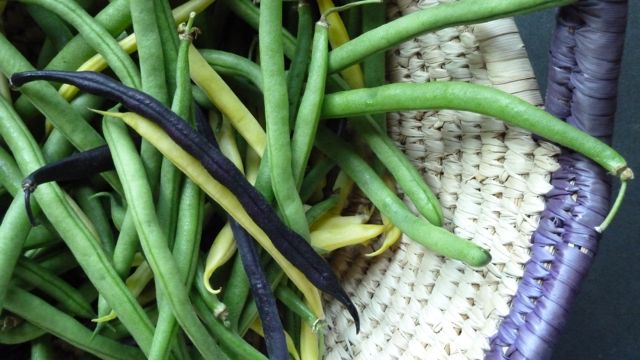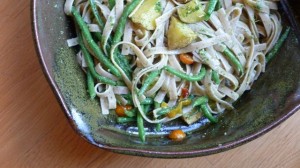 In our kitchen garden, vines scale a crude trellis fashioned from mismatched scraps of wood, lashed together with twine. Curly green tendrils flex and extend like wispy arms, to grab hold of anything within reach—a neighboring tomato plant or low-hanging tree branch. Their grip is surprisingly firm and unrelenting. There’s no way to wiggle free of this tangled hug.
In our kitchen garden, vines scale a crude trellis fashioned from mismatched scraps of wood, lashed together with twine. Curly green tendrils flex and extend like wispy arms, to grab hold of anything within reach—a neighboring tomato plant or low-hanging tree branch. Their grip is surprisingly firm and unrelenting. There’s no way to wiggle free of this tangled hug.
Our scarlet runners have woven a leafy canopy—like a living teepee—embellished with occasional bursts of red flowers. Peeking amongst the leaves, we spy thin dangling pods, nearly hidden from view, like earrings nestled in a mane of thick hair. Beans. Long and lithe. Tender, yet crisp.  We might steam them lightly and toss into salad or sauté in olive oil with tomatoes and garlic (pictured at right). They’re stirred into soup, tossed with fettucine and potatoes (pictured below left) or simmered in saffron-spiked paella. Roasted onions and nuts dress them up. With a squeeze of tangy lemon juice. There’s no denying, we love our summer string beans.
We might steam them lightly and toss into salad or sauté in olive oil with tomatoes and garlic (pictured at right). They’re stirred into soup, tossed with fettucine and potatoes (pictured below left) or simmered in saffron-spiked paella. Roasted onions and nuts dress them up. With a squeeze of tangy lemon juice. There’s no denying, we love our summer string beans.
 Years ago, our two year old suddenly refused all fruit and vegetables. Except for one. For two long years, she happily gobbled up green beans. Popped them into her mouth, one by one, with chubby fingers. No honey-glazed carrots or buttery potatoes. How about a strawberry, sweetie? No! Beans! So, beans it was. Only beans. Ever since I’ve had a soft spot for beans as well. They saved my child from a potentially nutrient-barren diet of pale carbohydrates, and singlehandedly nourished her until she finally relented and ate a strawberry. Eventually followed by more. There must be something special about a vegetable that’s singled out in that way—from an endless array of softer, sweeter and less obviously green possibilities.
Years ago, our two year old suddenly refused all fruit and vegetables. Except for one. For two long years, she happily gobbled up green beans. Popped them into her mouth, one by one, with chubby fingers. No honey-glazed carrots or buttery potatoes. How about a strawberry, sweetie? No! Beans! So, beans it was. Only beans. Ever since I’ve had a soft spot for beans as well. They saved my child from a potentially nutrient-barren diet of pale carbohydrates, and singlehandedly nourished her until she finally relented and ate a strawberry. Eventually followed by more. There must be something special about a vegetable that’s singled out in that way—from an endless array of softer, sweeter and less obviously green possibilities.
So fourteen years later, we grow beans in our garden. Just in case another finicky toddler comes to call. And because we adore them.
String beans aren’t always green, you’ll find them in hues of yellow and purple too. They bring a wide range of nutrients to the dinner plate such as immune system supporting Vitamin C, Vitamin A and Vitamin K (important for bone health), plus folate, iron, manganese and potassium.
To retain their bright green color and optimal flavor and texture, steam beans for about 5 minutes. Beyond that they begin to gray. Even so many cultures relish what we might consider a mushy, overcooked bean. Head straight to India or the Mediterranean, and you’ll see what I mean. Stirred into flavorful stews and sautés with onions, garlic, spices and herbs, the extra cooking doesn’t seem to hurt one bit. In fact, you may learn to adore the intensity of a fully cooked bean.
Recipes for the week:
French Potato Salad with Beans and Tomatoes
Pasta with Pesto, Potatoes and Green Beans
Green Beans with Tomatoes and Garlic
Indian-Style Potatoes with Green Beans
Quick Tips:
Toss beans and thin wedges of onion in a small amount of olive oil. Roast in a 375 degree oven for about 30 minutes, until vegetables are tender and have acquired a few caramelized brown spots here and there. Season with salt and fresh lemon zest and juice. A handful of chopped Spanish Marcona almonds add the finishing crunch.
 Raspberries and mint jazz up a lime spritzer. Muddle together a handful of mint leaves with four berries and a pinch of sugar in a tall glass. If you don’t have a muddler, use a wooden spoon. Mash in the glass to release the juice and minty aroma. Add 1/2 cup store-bought limeade and 1 cup sparkling water. Serve over ice.
Raspberries and mint jazz up a lime spritzer. Muddle together a handful of mint leaves with four berries and a pinch of sugar in a tall glass. If you don’t have a muddler, use a wooden spoon. Mash in the glass to release the juice and minty aroma. Add 1/2 cup store-bought limeade and 1 cup sparkling water. Serve over ice.
 How about a berry-spiked ice cream sandwich? Soften a half pint of high-quality vanilla ice cream. Mash 1/4 cup raspberries in a bowl and stir in ice cream. Place in freezer for one hour, until ice cream is firm. Put a scoop of berry ice cream on a store-bought chocolate wafer (such as Nabisco Famous Chocolate Wafers) and sandwich another on top. Push down gently. Freeze for an hour. Makes four.
How about a berry-spiked ice cream sandwich? Soften a half pint of high-quality vanilla ice cream. Mash 1/4 cup raspberries in a bowl and stir in ice cream. Place in freezer for one hour, until ice cream is firm. Put a scoop of berry ice cream on a store-bought chocolate wafer (such as Nabisco Famous Chocolate Wafers) and sandwich another on top. Push down gently. Freeze for an hour. Makes four.

